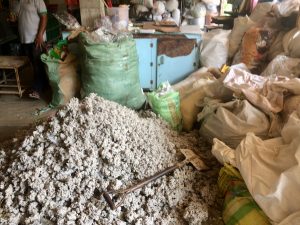
Video of an experiment I made visiting a backyard plastic recycler in a village outside of Colombo. We are doing an experiment to ‘test’ what kind of plastic constitutes these objects. In the rural context, there is no lab to verify if the plastic is #2 or #6 etc., so those who work in plastics (recyclers, pickers, buyers) have developed methods to figure out the different types of plastic. The “sink or float test” and also the “taste test” are two methods that serve the purpose of identifying material composition. In the case of this video, this handmade tile of polypropylene floats and the small piece of polystyrene sinks. At the end of the clip I pan to bags of plastic pellets in various colors, awaiting their reincarnation into another plastic mold form. The above photo is in the same workshop, and shows a pile of shredded polypropylene. This plastic will then go through another shred process and then it is melted and a desired coloring is added, and then the melted plastic is pushed through a spaghetti type mold into long strings (these can be seen in the video). These plastic strings fall into a cooling basin and then are put into a cutting machine that turns them into small rabbit-feed sized pellets. I wondered about whether those who man this machinery wear masks and protective gear (The day I arrived was a religious holiday and a day off for the workers; every other day almost is a religious holiday in Sri Lanka so it’s almost impossible for scheduling). The answer was that the workers employed (approx 50) complain of the added heat when wearing face masks and gloves, so they don’t wear them (and neither does the manager). The building is outside in these humid temperatures, with 3 walls and a roof. I was also very curious about the water in the cooling basin and its potential toxicity (Where does this water get disposed of? How often is it changed? The cooling basin is where we had the ‘plastic sink or float test’). I was taken completely aback to learn that there are little fish living in this water to eat mosquito eggs and keep the area free of dengue! Amazed, I scanned the water more closely and sure enough, there were little fish inside the dark water and they all appeared to be living. He did say that there are times when they die – potentially the canary of the backyard recycling business.
This experiment is also an example of how plastics stratify by weight once in an aquatic (marine, river) environment. Knowing this in the context of ocean cleanup, collecting various types of plastic loose in the marine environment is not just as simple as dragging a net across the water as there are multiple layers. Another variable to add to the equation is that plastic weight varies as organisms collect on the plastic the longer it is loose in the environment.
